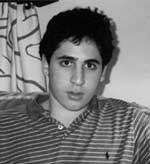|

The
Courage to Face Dyslexia: A Personal Student’s Voyage
By
Pola Rosen, Ed.D.
Adam
Koplewicz, a sophomore at Columbia Grammar and Preparatory School,
speaks candidly about living with dyslexia. His research, reading
and experiences have enabled him to share his knowledge with the
expertise of a graduate student. In fact, he recently gave a 15
minute presentation on how teachers can help dyslexic students
at the Dalton School. As Adam explained, dyslexia refers to the
inability to decode or read; words and letters appear as a jumble.
Recent research has indicated that it is a genetic disorder frequently
affecting more than one family member. Dyslexic individuals are
often bright achievers who have to work much harder than their
peers to accomplish the same level of work. Adam emphasized that
frequently, frustration and anger can accompany the learning process.
As a nursery school student, Adam remembers that he talked and
talked and was enthusiastic, but his speech didn’t make sense.
At about age 3 he was tested; the diagnosis was a learning disability.
His parents were told that he would only have difficulties when
he went to 3rd or 4th grade and was given more complex work or
had to take standardized tests.
A speech therapist who played games was very helpful when Adam
was 4 years old. Adam remembers one of them: he had to take photographs
on the weekend and then tell what happened in each picture. This
would help enhance his verbal skills.
“I
was always a strong student and as smart as my friends,” Adam
states confidently. “When school situations occurred that made
me uncomfortable, I learned tricks to either compensate or avoid
work. For example, in kindergarten, if the questions were too
difficult, I would go to the bathroom just before it was my turn.
By the time I came back, it wasn’t my turn anymore. I even calculated,
when I got older, how many minutes it would take until they called
on me, and figured out how long I had to be gone. There were times
I felt very frustrated.”
Adam started phonics the summer between 3rd and 4th grade. He
attended a program called Lindamood-Bell for 4 hours a day and
it “helped me drastically.” During the 4th grade he attended Lindamood
after school for 3 weeks. As a result his reading improved.
Seventh grade was the worst, according to Adam. He had a history
text, had to take notes, read poetry and write English papers.
It was a very frustrating year, requiring a great deal of effort
on his part. Fortunately, he received a great deal of support
from his parents, siblings and a phonics tutor (which he has to
this day). A family decision was made to transfer Adam to Columbia
Grammar Preparatory School, which is more structured than his
previous school. In addition to his spending so much time on his
studies and tutoring, Adam has someone look over his papers before
he hands them in. He takes class tests on the computer and has
just begun using software by Kurzweil that scans text and reads
it aloud.
“It’s
terrific,” says Adam. “Dyslexia makes you feel dependent on others,”
he explains, and these tools help you gain confidence in your
own abilities.”
Favorite classes now are science research, a 3-year course, in
which Adam and 7 other students can chooses any topic they want,
study for 1 and 1/2 years and then do field research. There are
3 teachers to guide and advise them. Adam’s research concentrates
on dyslexia and he plans ultimately to do a type of PET scan to
uncover what part of the brain is activated by
reading.
Adam’s advice to parents is useful and practical. “Seek remediation
as soon as possible and as much as possible; minimize the learning
disability and maximize the strengths of your child; let your
child participate in sports, art, science, social activities,
whatever they do well in; explain to the kid what’s going on and
never say you’re a bad reader, reiterate you’re smart and you’re
intelligent. Self-esteem is very important. It’s also helpful
to ‘hear’ stories about dyslexic people who are successful.”
Adam recommends a book, Learning Between the Lines, which
deals with a dyslexic student who goes from one school to another
and later becomes a superstar at the University of Pennsylvania.
Adam also met an inspiring man from Goldman Sachs who has dyslexia.
Many people don’t know that Governor Nelson Rockefeller (NYS)
as well as the famous poet William Butler Yeats were dyslexic
and yet climbed to the pinnacle of their professions.
Tips for teachers from Adam are excellent:
1.Teachers should tell students exactly what’s expected of them.
As soon as you know the dates for term papers, tell your students
so they can budget their time.
2. Write all information on the board.
3. Try not to take points off for spelling or grammar. Look at
the content. Quality is what should be graded.
4. Try to specify which words must be spelled correctly.
Some school accommodations are in place now: allowing double time
for the SAT exams and help by getting a reader or writer are invaluable
for dyslexic students.
Adam Koplewicz illustrates the courage , persistence and endurance
that are required to overcome the odds.#
Education Update, Inc., P.O. Box 20005, New York, NY 10001. Tel:
(212) 481-5519. Fax: (212) 481-3919. Email: ednews1@aol.com.
All material is copyrighted and may not be printed without express consent of
the publisher. © 2001.
|

